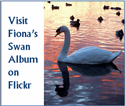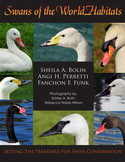Ask the Swan Specialist
Date: 5 November 2014
Hi Jerome:
There isn't much difference between how adult swans behave as opposed to their cygnets. Just think of you and your parents. You both have the same behavior because you are humans, just a different age.
So, just like human babies or juveniles, the swan cygnets will exhibit the same behavior of being a swan, but may act a little immature in their behavior. For example, both adults and cygnets will bathe, preen (zip their feathers and rub the oil from their uropygial oil-preen gland over their feathers to maintain water repellency), eat, sleep and swim. The cygnets may eat and follow their parents, learning how to be a swan and will listen to their parents. The parents are there for protection, should they see or sense danger (predators, etc.,) they will alert the young birds and the cygnets will immediately respond by sticking close to their parents or diving under the water to eventually meet up with their parents on the other side of the pond/lake after the danger has passed.
Cygnets will play and chase each other and their parents. Eventually, as they age, the older swans will get tired of having to watch them closely and the young birds may venture farther away from their parents (just out of sight). However, if danger is sensed, the parents will react by calling to the cygnets or swimming/flying to them for protection.
If the cygnets are extremely small, you may see the mother swan (pen) carrying the cygnets on her back for not only shelter, but to allow them to rest while she continues to eat and swim. The male (cob) will always be on patrol protecting the new family.
Most cygnets will begin to take on the size of their parents around 6-8 months of age. Feather color will turn from taupe/gray to white at approximately 6-8 months of age with the bottom of the wings turning first. At approximately 10 months of age, the cygnets will be totally white, but they will not take on the full color of their bills (orange-Mute Swans) (black-Tundra or Trumpeter Swans) (Black-Yellow Bewick/Whooper Swans) (Coral-Coscoroba Swans).
Black Swans will be taupe in color and then their feathers will turn black and their bills eventually red in color once they mature. (Red/Black Swans) Black-Necked Swan cygnets will eventually turn colors with their neck feathers turning black and their bills taking on the caruncle blue/red look.
We hope this information is of benefit to you as you observe the family. They will provide you with many hours of endless enjoyment. ENJOY! The Regal Swan
Messages In This Thread
- Observation of adults and juveniles behaviours -- Jérôme -- 5 November 2014
- Re: Observation of adults and juveniles behaviours -- The Regal Swan -- 5 November 2014
Ask the Swan Specialist is powered by
Tetra-WebBBS 5.30 Beta © 2006-2007 Tetra-Team






